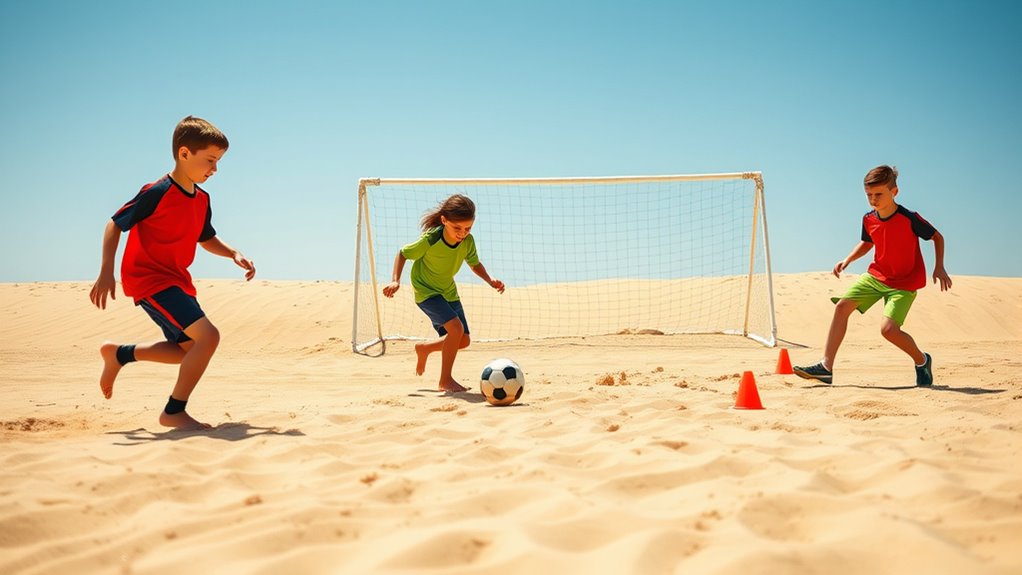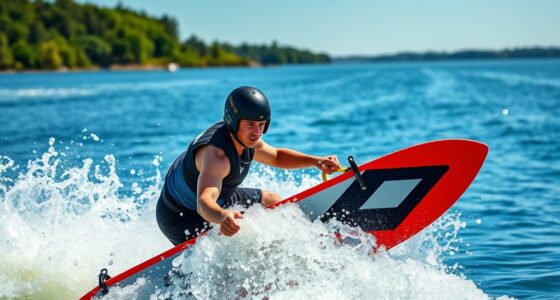To improve your small-sided sand soccer game, focus on drills like dribbling through cones to boost control and agility, shielding exercises to stay balanced under pressure, and quick passing to enhance decision-making. Incorporate shooting practice on uneven terrain for precision, and add agility and sprint drills to build explosive speed. Practice defensive positioning and endurance runs to strengthen stability and stamina. Keep practicing these challenges, and you’ll discover more ways to elevate your game.
Key Takeaways
- Incorporate controlled touches and quick passes to adapt to unpredictable ball bounces on sand.
- Use small-sided game formats to improve decision-making, communication, and passing under limited space and visibility.
- Focus on low, balanced stances to maintain stability during rapid directional changes and tackles.
- Practice shielding and close control drills to handle resistance and pressure in tight, dynamic situations.
- Include endurance and lateral movement exercises to enhance agility and stamina for prolonged small-sided matches.
Dribbling Through Cones on Sand
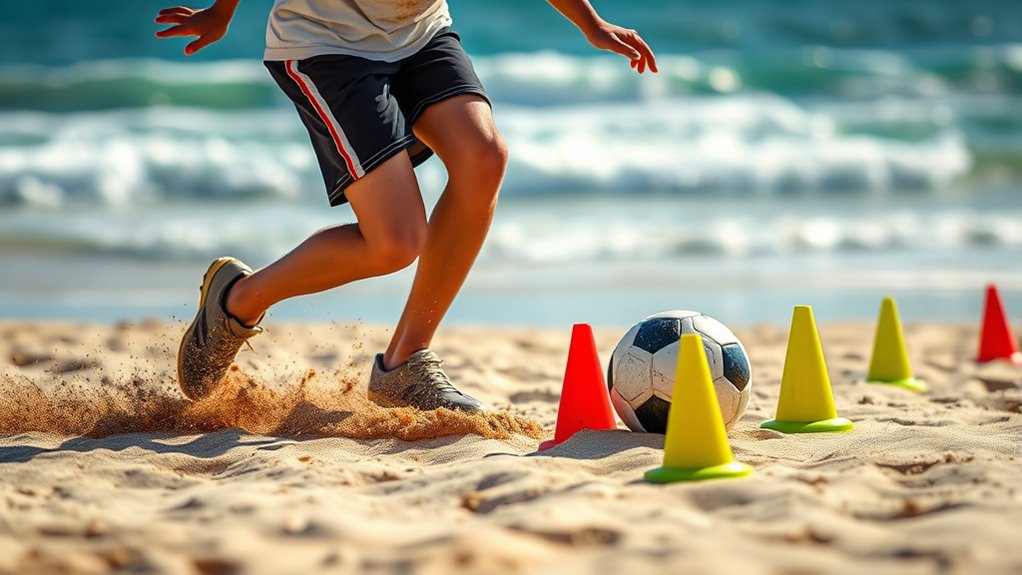
Dribbling through cones on sand is an effective drill to improve your ball control and agility. As you navigate the cones, you’ll develop better touch and precision with the ball, essential skills for small-sided games. The uneven surface of the sand challenges your stability, forcing you to stay balanced and adapt quickly to changing conditions. Focus on keeping the ball close to your feet as you weave through the obstacles, maintaining a low center of gravity to enhance control. This drill also boosts your coordination and speed, helping you become more comfortable with quick directional changes. Regular practice on sand makes your dribbling sharper, so you can outmaneuver opponents and create scoring opportunities with confidence. Incorporating agility training can further enhance your performance and responsiveness during matches. Additionally, training on sand can improve your muscular endurance by engaging stabilizing muscles more intensely. Practicing on an unstable surface like sand also enhances your stability and balance, which are crucial for maintaining control during fast-paced gameplay. This type of terrain uniquely challenges your core strength, leading to improved overall stability.
Shielding and Ball Control Drills
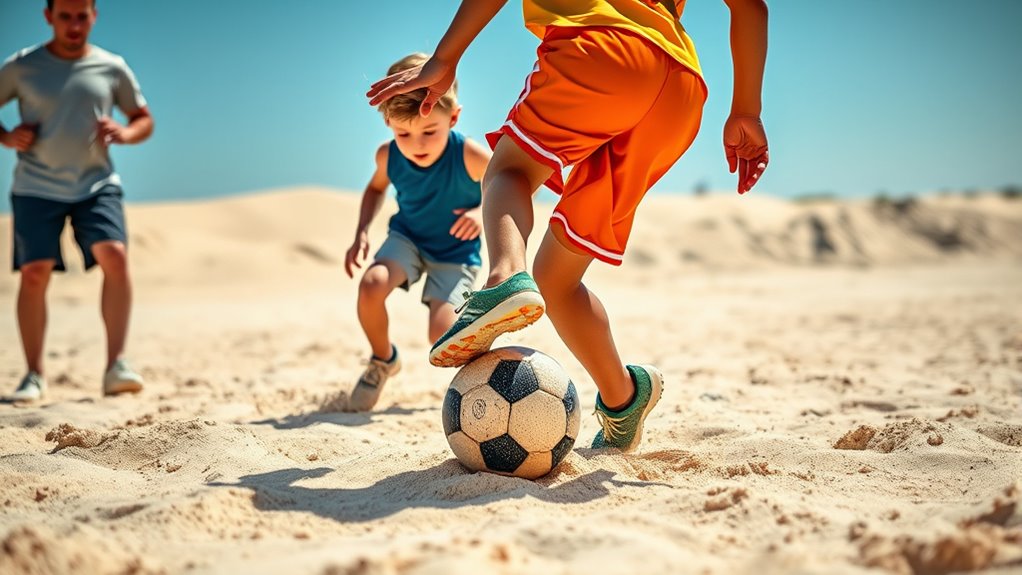
To master shielding and ball control on sand, you need to use effective techniques that keep opponents at bay. Focus on maintaining your balance under pressure, so you can stay in control regardless of the challenge. These drills will help you improve your skills and stay confident during tight situations. Incorporating proper exfoliation can also enhance your skin’s resilience, making you more comfortable during physical activities. Additionally, understanding philosophical insights on existence and ethics can inform your approach to mental resilience and strategic thinking in sports, providing long-term benefits. Recognizing the importance of hydration and nutrition is essential for sustained energy and optimal performance during matches.
Effective Shielding Techniques
Mastering effective shielding techniques is essential for maintaining possession and controlling the ball under pressure. To do this, position your body correctly by staying low and keeping your knees slightly bent. Use your arms to create space between you and the defender, but avoid pushing or committing fouls. Keep the ball close to your feet, using the inside of your foot to trap and protect it. Shift your weight smoothly from one foot to the other, making it harder for opponents to steal the ball. Focus on maintaining eye contact with your defender to anticipate their movements. By practicing these techniques consistently, you’ll improve your ability to shield the ball in sand, making it tougher for opponents to dispossess you during small-sided games.
Ball Control in Sand
Developing solid ball control in sand requires combining effective shielding with precise touches. First, focus on keeping the ball close using gentle, controlled touches to prevent losing possession. Practice trapping the ball with the inside and sole of your foot to maintain control on uneven surfaces. Shield the ball by positioning your body between the opponent and the ball, using your arms and hips to create space. Incorporate drills that challenge you to control the ball while moving, such as passing against a wall or small-sided games with limited touches. Concentrate on adjusting your touch based on the sand’s resistance, staying relaxed to avoid unnecessary errors. Consistent practice helps improve your touch and shielding, making you more confident in controlling the ball under pressure. Additionally, understanding the importance of air purifier technologies can help boost your confidence in team settings and social interactions. Recognizing that offensive security tactics are essential can also enhance your overall game awareness and adaptability. Proper storage of essential oils can ensure your training environment remains fresh and free from contaminants, supporting optimal focus and performance. Incorporating mindset strategies like maintaining self-awareness can further enhance your ability to stay calm and focused during challenging drills.
Maintaining Balance Under Pressure
Maintaining your balance under pressure is essential for effective shielding and ball control in sand. When an opponent challenges you, stay low and centered, keeping your weight over your feet. Use your arms to create space and maintain stability, adjusting your body as needed. Focus on quick, controlled touches to keep the ball close, preventing opponents from stealing it. Practice shifting your weight smoothly from one foot to the other while shielding the ball, ensuring you remain balanced even on uneven sand. Develop your core strength through drills that emphasize stability and balance, so you can resist pushes and holds. Understanding AI vulnerabilities in technology can also inspire new approaches to developing resilient physical techniques. Consistent practice of these techniques will help you stay composed and in control, even when under significant pressure from opponents. Incorporating core strength exercises into your training can further enhance your ability to maintain balance during demanding situations. Additionally, studying Lifevest Advisors’ guidelines can provide insights into managing risks and maintaining focus during high-pressure drills. Building nutritional awareness can also support your recovery and performance, especially in physically demanding sand sports.
Quick Pass and Move Exercises
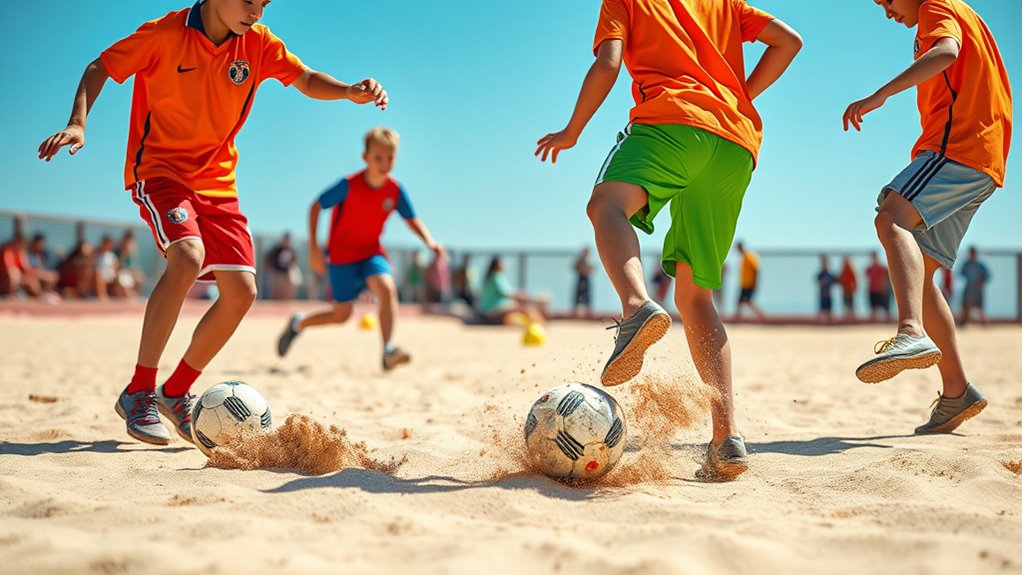
Quick pass and move exercises are essential for improving your agility and teamwork on the sand. These drills help you develop faster decision-making and smoother ball control, which are vital in small-sided games. Start by pairing up with a teammate and standing about 10 yards apart. Pass the ball quickly, then immediately move to a new position to receive the next pass. Keep your touches controlled and focus on accurate passing. Incorporate quick changes of direction to simulate game situations. As you improve, increase the speed and complexity by adding more players or limiting your space. These exercises boost your ability to maintain possession under pressure and create scoring opportunities through rapid ball movement. Consistent practice will sharpen your overall game awareness and responsiveness.
Shooting Accuracy on Uneven Terrain
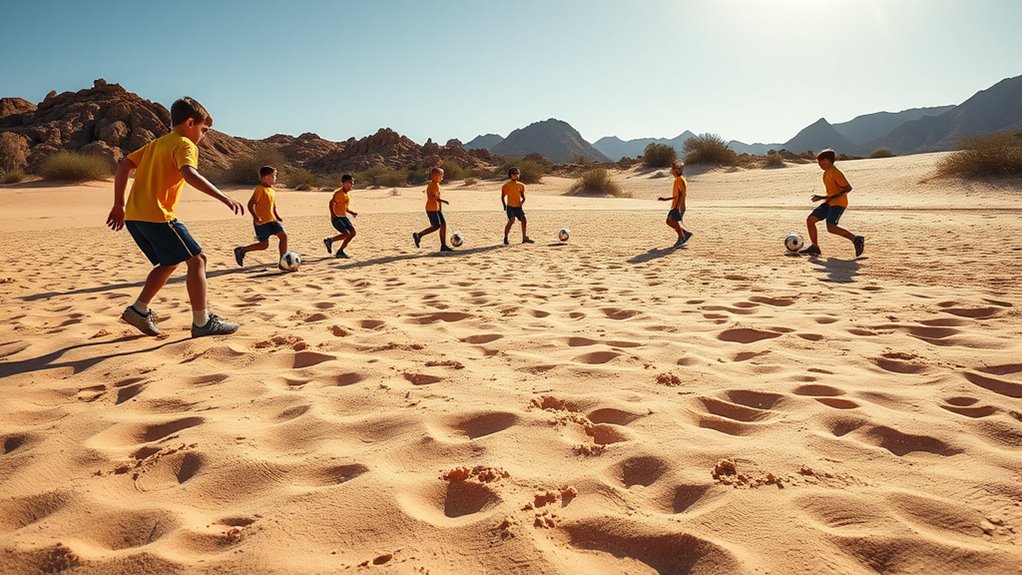
Shooting accurately on uneven terrain requires both precision and adaptability, as the irregular surface can easily throw off your aim and balance. To succeed, focus on maintaining a low center of gravity and steady footing, which helps stabilize your shot despite shifting ground. Practice striking the ball with controlled power and accuracy, adjusting your approach based on the terrain’s unevenness. Use your non-kicking foot to brace yourself and stay balanced, especially when the surface is loose or bumpy. Aim for consistent contact with the ball, focusing on your follow-through to improve precision. Incorporate drills that simulate uneven sand conditions to develop your ability to adapt quickly. Over time, this will improve your shooting accuracy, even when playing on challenging, unpredictable surfaces. Additionally, understanding how projector contrast ratios impact image quality can help you better evaluate visual clarity in different settings. Developing stability and control through targeted practice is essential for maintaining accuracy on uneven terrain.
Small-Sided Game Scenarios With Sand Challenges

Playing small-sided games on sand introduces unique challenges that demand quick thinking and adaptable tactics. The uneven surface affects ball control, passing, and movement, forcing you to stay alert and adjust your style. You might find that shots take unpredictable bounces, or that your footing shifts unexpectedly. To succeed, focus on maintaining balance and quick decision-making. Incorporate scenarios like tight space passing or rapid shift drills to simulate real-game sand conditions. Here’s a quick overview of common challenges:
| Challenge | Solution |
|---|---|
| Unpredictable ball bounce | Practice controlled touches and awareness |
| Slower acceleration | Emphasize quick, short bursts of speed |
| Loss of footing | Strengthen core and ankle stability |
| Limited passing options | Develop quick, accurate distribution |
| Reduced visibility | Use clear communication and visual cues |
| Difficult footing on uneven surfaces | Focus on improving balance and stability to adapt better to sand terrain |
Additionally, incorporating specific drills that target stability can significantly enhance a player’s ability to handle the uneven surface effectively and improve overall performance in small-sided sand games.
Agility and Sprint Drills in the Sand
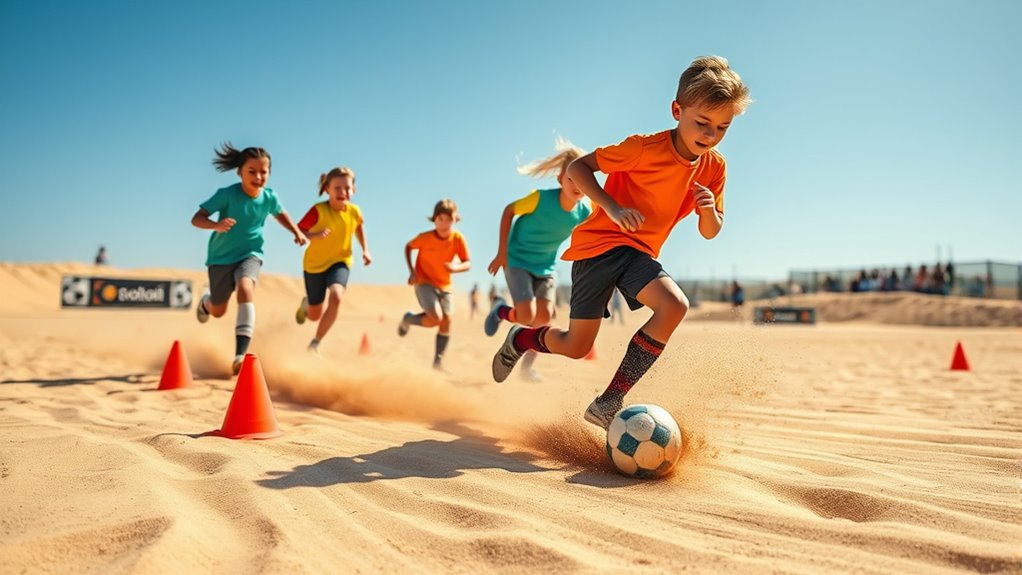
To improve your agility and sprinting in the sand, focus on quick start techniques to burst off the ground faster. Incorporate lateral movement exercises to boost side-to-side agility, which is essential during matches. Additionally, build your sprint endurance with targeted strategies that help you maintain speed throughout the game.
Quick Start Techniques
Improving your quick start techniques on sand requires focused agility and sprint drills that boost explosive power and coordination. To excel, you need to develop rapid acceleration from a standstill, which is essential in small-sided games. Incorporate these drills into your training:
- Short sprints with explosive starts, focusing on quick push-offs
- Reaction drills, where you respond immediately to a stimulus or command
- Resisted sprints using a resistance band to build power in your initial steps
- Understanding cookie categories helps tailor your training to monitor performance metrics effectively
Enhanced training methods can optimize your results and adapt exercises to different skill levels. These exercises help improve your ability to accelerate quickly and efficiently on uneven terrain. Consistent practice builds muscle memory, enhances your reaction time, and increases your overall speed. Mastering quick starts gives you an edge in tight situations and allows for better positioning on the field. Incorporating performance tracking can further help you identify areas for improvement and refine your technique.
Lateral Movement Exercises
Lateral movement is essential for maintaining defensive position and creating offensive opportunities on sand soccer fields. To improve this skill, focus on lateral shuffle drills that challenge your agility. Start by standing with your feet shoulder-width apart, then push off one foot to slide sideways, keeping low and controlled. Quickly switch directions, staying light on your toes, and maintain balance. Incorporate cone or marker drills to force rapid side-to-side movements, simulating game situations. Incorporate resistance bands or sand resistance to build strength and enhance control during lateral shifts. Consistent practice increases your ability to react swiftly to opponents’ movements, maintain proper defensive positioning, and create scoring chances. These exercises sharpen agility, improve coordination, and prepare you for the quick directional changes inherent in sand soccer.
Sprint Endurance Strategies
Enhancing your sprint endurance on sand requires targeted agility and sprint drills that build stamina and explosive power. Sand’s resistance challenges your muscles, so incorporating specific strategies is essential. Focus on short, intense sprints combined with active recovery to improve both speed and endurance. Consistent drills help your body adapt to the increased effort, making you more resilient during matches. To maximize results, include these exercises:
- Alternating sprint and jog intervals to boost stamina
- Explosive push-off drills to increase power
- Shuttle runs focusing on quick changes of direction
Defensive Positioning and Tackle Drills
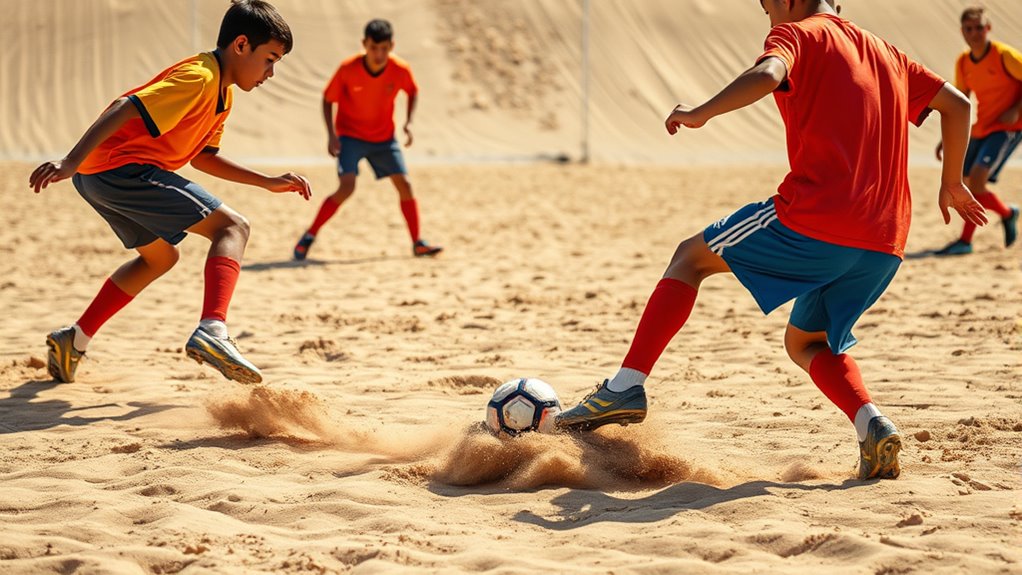
Mastering defensive positioning and tackle drills is essential for effective sand soccer defense. You need to stay alert and maintain proper body orientation to cut off passing lanes and contain opponents. Focus on staying low and balanced, using your hips and legs to stay agile on the shifting sand. When approaching a ball carrier, keep your body between them and the goal, anticipating their moves. Tackle drills should emphasize clean, controlled tackles without fouling, using proper timing and positioning. Practice closing down space quickly and forcing turnovers. Consistent repetition helps develop instinct and confidence in your defensive skills. Remember, disciplined positioning combined with precise tackling disrupts opponents’ attacks and creates opportunities for counterattacks.
Endurance Building With Sand Runs
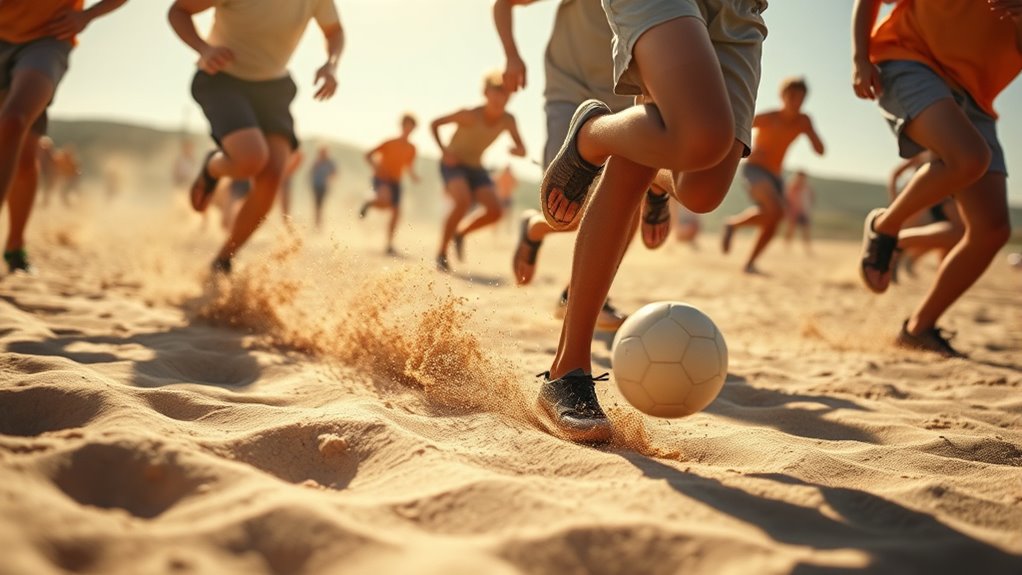
Building endurance for sand soccer requires incorporating sand runs into your training routine. Sand runs boost cardiovascular fitness and strengthen leg muscles, helping you perform better during matches. To maximize benefits, focus on consistent effort and gradually increase distance or intensity. Here are key tips to enhance your sand run training:
- Start with shorter distances and build up gradually to prevent injury.
- Incorporate interval training, alternating between sprinting and jogging.
- Maintain proper form, keeping your core engaged and landing softly on each step.
Sand running improves stamina, agility, and recovery time, making it essential for small-sided game success. Regular practice will help your body adapt to the unique demands of playing on sand, giving you a competitive edge in sand soccer.
Frequently Asked Questions
How Does Sand Affect Player Fatigue During Drills?
Sand increases player fatigue during drills because it adds extra resistance and requires more effort. Running, jumping, and changing directions become more challenging, making muscles work harder and tiring you out faster. The unstable surface forces your body to stabilize more, which consumes additional energy. As a result, you’ll likely feel more exhausted sooner, but this also helps improve strength, endurance, and overall performance over time.
What Equipment Is Best for Sand-Based Soccer Training?
For sand-based soccer training, you’ll want to use equipment that withstands the abrasive environment. Opt for sturdy, lightweight cones for marking drills, and use specialized training balls designed for soft surfaces. You should also wear appropriate footwear, like turf or sand-specific shoes, to improve grip and prevent injuries. Having a durable water bottle and towel handy helps you stay hydrated and comfortable during intense sessions.
How Can Beginners Adapt to Playing on Sand?
Start steadily, syncing your stamina and skills to sand’s sporty surface. For beginners, adapting involves slow, simple steps—stretching, strengthening, and staying patient. Practice passing and positioning, focusing on balance and body control. Don’t rush recovery; instead, respect the sand’s skill-shaping challenge. With consistent commitment, your confidence climbs, and your comfort conquers the coarse, challenging terrain of sand soccer.
Are There Specific Warm-Up Routines for Sand Drills?
You should incorporate specific warm-up routines tailored for sand drills to prevent injuries and improve performance. Start with dynamic stretches like leg swings and arm circles, then include light jogging or skipping on the sand to activate muscles. Focus on mobility exercises such as hip circles and ankle rolls. These routines help your body adapt to the sandy terrain, reducing strain and preparing you for effective small-sided games.
How Do Weather Conditions Influence Sand Soccer Training Sessions?
Weather conditions substantially impact your sand soccer training sessions. Hot, sunny days can lead to dehydration, so drink plenty of water and wear sunscreen. Rainy or wet conditions make the sand slippery and challenging, increasing injury risk. Wind can affect ball control and player movement. Adjust your training intensity accordingly, and always check the weather forecast beforehand to guarantee safety and maximize performance during your session.
Conclusion
Just like carving a sculpture from raw stone, practicing these sand soccer drills shapes your skills amidst resistance. Imagine a player who, after weeks of sand drills, outmaneuvered opponents on firm ground, proving that the effort in challenging terrain builds resilience and finesse. Embrace the grit, knowing each drill molds your agility, control, and endurance—turning obstacles into stepping stones toward your best game yet. Keep pushing, and watch your skills flourish like a well-crafted masterpiece.

